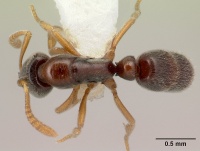Hypoponera mixta
| Hypoponera mixta | |
|---|---|

| |
| Scientific classification | |
| Kingdom: | Animalia |
| Phylum: | Arthropoda |
| Class: | Insecta |
| Order: | Hymenoptera |
| Family: | Formicidae |
| Subfamily: | Ponerinae |
| Tribe: | Ponerini |
| Genus: | Hypoponera |
| Species: | H. mixta |
| Binomial name | |
| Hypoponera mixta Bolton & Fisher, 2011 | |
Nothing is known about the biology of Hypoponera mixta.
Identification
Bolton and Fisher (2011) - Closely related to Hypoponera jeanneli but larger and has the first gastral tergite broader in relation to the second.
A member of the abeillei group.
Keys including this Species
Distribution
Latitudinal Distribution Pattern
Latitudinal Range: 0.6° to 0.6°.
| North Temperate |
North Subtropical |
Tropical | South Subtropical |
South Temperate |
- Source: AntMaps
Distribution based on Regional Taxon Lists
Afrotropical Region: Kenya (type locality).
Distribution based on AntMaps
Distribution based on AntWeb specimens
Check data from AntWeb
Countries Occupied
| Number of countries occupied by this species based on AntWiki Regional Taxon Lists. In general, fewer countries occupied indicates a narrower range, while more countries indicates a more widespread species. |

|
Estimated Abundance
| Relative abundance based on number of AntMaps records per species (this species within the purple bar). Fewer records (to the left) indicates a less abundant/encountered species while more records (to the right) indicates more abundant/encountered species. |

|
Biology
Castes
Nomenclature
The following information is derived from Barry Bolton's Online Catalogue of the Ants of the World.
- mixta. Hypoponera mixta Bolton & Fisher, 2011: 72, figs. 76-78 (w.) KENYA.
Unless otherwise noted the text for the remainder of this section is reported from the publication that includes the original description.
Description
Worker
(holotype in parentheses). Measurements: HL 0.68–0.74 (0.70), HW 0.56–0.60 (0.58), HS 0.620–0.665 (0.640), SL 0.50–0.54 (0.51), PrW 0.45–0.48 (0.47), WL 0.94–1.00 (0.96), HFL 0.52–0.54 (0.52), PeNL 0.20–0.22 (0.20), PeH 0.43–0.46 (0.45), PeNW 0.31–0.34 (0.32), PeS 0.313–0.333 (0.323) (12 measured). Indices: CI 78–83 (83), SI 87–93 (88), PeNI 68–72 (68), LPeI 43–49 (44), DPeI 145–170 (160).
Eyes absent. Apex of scape, when laid straight back from its insertion, fractionally fails to reach or just touches the midpoint of the posterior margin in full-face view; SL/HL 0.71–0.75. Cephalic dorsum finely reticulate-punctate. Pronotal dorsum almost smooth, obviously much less strongly and densely sculptured than cephalic dorsum. Metanotal groove absent from dorsum of mesosoma, though there may be a slight change of slope between mesonotum and propodeum. Mesonotal-mesopleural suture vestigial or absent from side of mesosoma. Propodeum weakly marginate between declivity and side. Posterior surface of petiole node with a series of very short cuticular ridges that radiate upward from the peduncle. Node of petiole in profile with the anterior and posterior faces weakly convergent dorsally, the dorsum shallowly convex. Petiole node in dorsal view with posterior face transverse and anterior face broadly convex, not thickly D-shaped. Subpetiolar process rounded or with a blunt ventral angle. Maximum width of first gastral tergite in dorsal view slightly greater than width of second gastral tergite at its midlength. Cross-ribs at base of cinctus of second gastral tergite short but conspicuous. Midline length of second gastral posttergite, from posterior margin of cinctus to apex, is slightly less than the width of the segment at its midlength. Disc of second gastral tergite with sharply incised small punctures that are relatively closely packed and separated by areas of glossy cuticle; the diameters of the punctures are equal to or slightly greater than the distances that separate the punctures. First gastral tergite in profile densely pubescent dorsally and with very few short setae that project above the level of the pubescence; the setae inconspicuous and not strongly differentiated from the pubescence.
Type Material
Holotype worker (top specimen of three on pin), Kenya: Nyandarua, 10 km. SE Njabini, nr For. Sta., 2550 m., 9.xi.1977 (V. Mahnert & J.-L. Perret) (Musee d'Histoire Naturelle Genève).
Paratypes. 8 workers with same data as holotype; 12 workers Kenya: Embu, Irangi For. Sta., 2000 m., 11.x.1977 (V. Mahnert & J.-L. Perret) (MHNG, The Natural History Museum, California Academy of Sciences).
References
References based on Global Ant Biodiversity Informatics
- Bolton B. and B. L. Fisher. 2011. Taxonomy of Afrotropical and West Palaearctic ants of the ponerine genus Hypoponera Santschi (Hymenoptera: Formicidae). Zootaxa 2843: 1-118
- Bolton, B., and B. L. Fisher. "Taxonomy of Afrotropical and West Palaearctic ants of the ponerine genus Hypoponera Santschi (Hymenoptera: Formicidae)." Zootaxa 2843 (2012): 1-118.
- Garcia F.H., Wiesel E. and Fischer G. 2013.The Ants of Kenya (Hymenoptera: Formicidae)Faunal Overview, First Species Checklist, Bibliography, Accounts for All Genera, and Discussion on Taxonomy and Zoogeography. Journal of East African Natural History, 101(2): 127-222
- Nousiainen A. 2017. Leaf litter ants in indigenous rainforest and coniferous plantations of the Taita Hills, Kenya. Master Thesis University of Helsinki, 53 pages.


